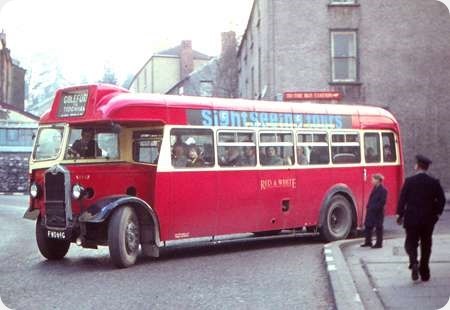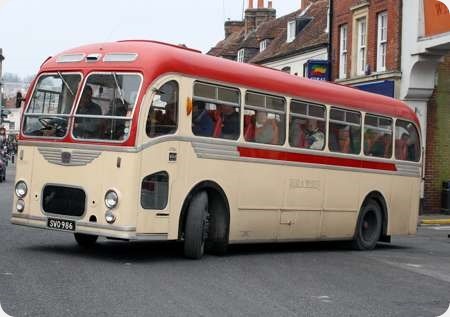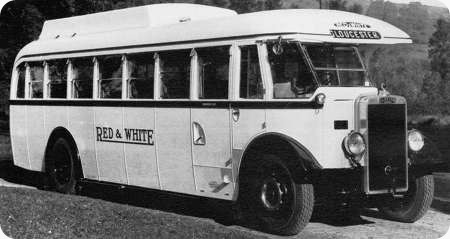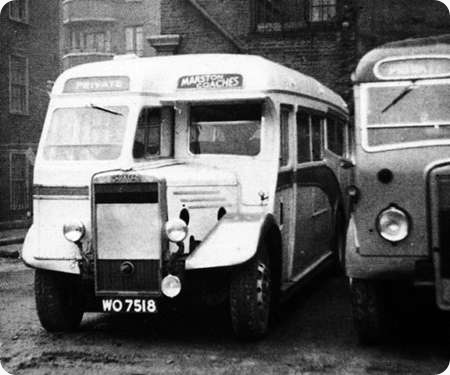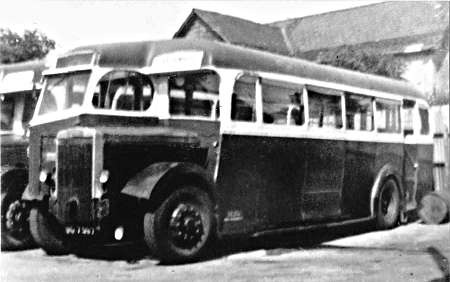Red & White – Albion Valkyrie CX13 – FWO 646 – S1447
Red & White Services
1947
Albion Valkyrie CX13
Bristol (Body Building Works -BBW) B35R
Living in Clevedon, Red and White territory was very close and could be seen easily but was not accessible except by paddle steamer, the mildly frightening Aust car ferry or a drive through Gloucester! This photo was taken on 24/03/1963, probably in Chepstow, on an expedition across the muddy waters. The fleet was very varied and strange to me, brought up on Tilling regularity, although it was rapidly changing as Tilling Group standard vehicles arrived en masse. This vehicle suddenly caught my attention as it looked like an ECW body to excite me in the gloom. I see from Richard Smith’s website that this 1947 chassis had a Pickering body when new. It was replaced in 1953 by a Bristol (Brislington Body Works) body. The BBW single deck design was very similar to ECW with the main identifier being that the side windows had square corners to the top sliding vents, but in this latter-day product, even that distinction had gone.
I was always bemused by the company’s fleet numbering system. It took me a few visits before I managed to fathom out how it worked! I assumed that it was designed by the secretarial / finance department so it could see how the company’s assets were depreciating! I can’t think that it held any advantages for operating or maintenance staff to know that this was the 14th single decker delivered (or was it ordered?) in 1947 (despite having a 1953 body!)
When I was on the Tilling Group graduate training scheme at Bristol, I went for an interview for a technical assistant post at Chepstow. I learned something there that I never forgot:
Q (from Doug Flooks, Chief Engineer): What fall does a water drain pipe need to ensure water will flow along it?
A (which I didn’t know): 1 in 40. A fact that I have actually used from time to time in various situations but still cannot convince domestic rainwater gutter installers!
Photograph and Copy contributed by Geoff Pullin
30/08/20 – 08:26
Interesting view, and thanks for posting. When I was being retrained from Admin to technical I was told that (certainly for highway drainage purposes) a fall of 1 in 200 was adequate to move the water!
Pete Davies
31/08/20 – 06:29
Location appears to be Albion Square, Chepstow. There is a sign directing to the bus station on the wall, above the rear of the vehicle. The Chepstow-Coleford service operated via Tidenham – route number was 29, although not displayed on that vehicle.
Nigel Frampton
01/09/20 – 06:14
In January ’64 I saw several of these delightful Valkyries (not sure which batch) in Monmouth as I was hitch-hiking towards West Wales. I should have taken more notice of registrations and other details, but time was against me with the shortness of the days. Here my memory probably tricks me: I thought I saw at least one (engine side cover removed) with a Gardner 4LW engine, which I understand was an option for the Valkyrie CX9, but from what I’ve read in Richard Smith’s very informative R&W fleet history there would have been no 4LW Albions there at that time. Very grateful if someone can set me straight on this one!
Ian Thompson
01/09/20 – 10:45
I know this is straying from buses, but ref water flowing downhill.
The Gloucester and Sharpness Canal between Gloucester docks and the top lock at Sharpness is approx 25.25km and the surface elevation drops from 13m to 4m, a gradient of approx 1:2807.
John Lomas
03/09/20 – 06:25
Red & White had got rid of most of their Albions by 1960 and just a few hung on. By 1964 there were just a few surviving CX39 Valiant coaches (demoted to buses and all out of service in 1964) and fifteen of the BBW-rebodied Valkyries as seen above which lasted until 1965. All of these had Albion engines so it is most unlikely that Ian saw a 4LW-engined version. Such a small engine would not be any use to Red & White who had hilly operating terrain.
The 29 service to Coleford via Tidenham saw just four through journeys a day, with a fifth on Saturday evenings. The odd thing was that two of these departures were at the same time! They followed each other most of the way but had slightly different routes between St. Briavels and Coleford. There was another route, also the 29, that ran via Tintern. This was referred to in timetables in later years as the 29A but I’ve never seen a picture of a bus showing that route number. In any case it later fizzled down to one journey a day to and from Brockweir only.
David Beilby
04/09/20 – 06:44
A small book about the Ledgard fleet which I purchased many years ago comments about the five ex-Red & White Valkyries which were bought by Ledgards in 1959, registered FAX and EWO but otherwise broadly same as the one illustrated above.
The author writes: "Passengers were treated to a rattling good time, the sheer body noise emanating from these had to be heard to be believed! – At the same time, they were just about the fastest buses on the Bradford – Harrogate route, their hill climbing being nothing short of extraordinary when handled by a good driver".
Chris Barker
06/09/20 – 06:14
David Beilby and Chris Barker: thanks for your comments, which jointly prove that the 4LW engine I thought I saw in a Red & White Valkyrie was just my imagination. Being CX13s they will have had Gardner 6LW engines—especially if the five inherited by Ledgard crested the West Riding hills with such ease. The only apart from those I saw in the yard at Monmouth the only Valkyrie I ever remember seeing in service was one of King Alfred’s, just north of Winchester. It was only 5 years old at the time (1955) but I assumed it was much older.
Ian Thompson
06/10/20 – 06:47
The CX13 Valkyrie had the Albion 6-cylinder 9-litre engine. The Gardner 6LW version was the CX11, but these were all prewar, not being reintroduced postwar. There was also a CX9 with a 4-cylinder Albion engine.
John Stringer
07/10/20 – 06:33
My understanding is that the 17ft 6ins wheelbase Albion Valkyrie CX, which was introduced at the 1937 Commercial Motor Show, was available in the following versions. All had a four speed constant mesh gearbox fitted in unit with the engine.
CX9 6.1 litre 85 bhp 4 cylinder petrol engine
CX11 Gardner 5LW
CX13 9.09 litre 120 bhp 6 cylinder petrol, or Gardner 6LW, this version having a longer engine bay
Production stopped at the outbreak of war and resumed in 1945.
CX9 6.6 litre 78 bhp four cylinder oil engine
CX13 9.09 litre EN242 105 bhp 6 cylinder oil – no Gardner options
The CX9 remained in the catalogue until 1950, but the CX13 was replaced in the home market in 1948 by the Valiant CX39 which had the 9.9 litre 120 bhp EN243B oil engine that was fitted also to the CX37 Venturer double decker. All production ended in 1950. Leyland took over the firm in 1951.
A list of Valkyrie production may be found on Bus Lists on the Web
Roger Cox
20/10/20 – 06:25
Geoff – that is a fine portrait of a R&W BBW-re-bodied Albion. May I point out, for the general benefit of all, the meaning of the term BBW – it actually stood for Body Building Works, plainly and simply, as it was a Bristol Tramways internal designation, to go along with the Motor Constructional Works (MCW) and Central Repair Works (CRW), having been introduced before WW1 while the company was building for its own or associated operations only. After 1920 and Bristol’s first appearance at the Commercial Motor Exhibition at Olympia, the plates attached to bodies completed at Brislington always carried the full BT&CC name and "Bristol" as the site and never Brislington. The body on the R&W Albion is an evolution of the post-WW2 Tilling Standard pattern, revised almost annually for the BT&CC fleets until the 1951 product was very similar indeed to the ECW body, then further developed, with a revised glazing style, for R&W’s 45 Albions. These were bodied from Autumn 1951 to late 1953 and were to BBW’s S23 pattern. BBW built over 2,300 bodies before closure in 1955 and full details are given in my 1999 book, "Coachwork by Bristol Tramways". Geoff, I, too, am from Clevedon. I was born there in 1945 and, after being weened on Js and Ls, or Ks on the Bristol service, moved in 1958 into Bristol. Are you related to Pullins the bakers, where we bought our bread?
Allan Macfarlane
21/10/20 – 06:39
Allan, yes, my father and his brother ran the company set up by their father at Yatton and then Clevedon. The company is still run by my cousin and his family. I got up at 4am in school holidays to help make hot cross buns, Christmas bread etc to earn some pocket money but it was not for me!! So got a couple of holiday jobs with BCV and BOC and ended up on Tilling senior trainee scheme (at BCV and BOC!) after graduating at Liverpool.
Thanks for the info on BBW – I knew it was an internal designation but not sure of its actual wording. At an early time at BCV, the Brislington BOC depot (on the corner of the A4) had a far corner in which I took to be BCV built the trailers to go with the HA tractor units for BRS.
I came across three letter codes like BBW, CRW etc again in my first job at ECOC. Every depot and post had a two or three letter code; DMS/YAR = Depot Mechanical Superintendent Yarmouth. I was DA/Eng = Deputy Assistant Engineer reporting to A/Eng and CE!
Geoff Pullin
21/10/21 – 05:40
Living in Lydbrook I travelled on Red & White buses to either Coleford or Cinderford and travelled on Albion Valkyrie BBW B35R buses also travelled on some which had a Lydney B35F body.
Michael Stephens
Quick links to the - Comments Page - Contact Page - Home Page
